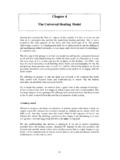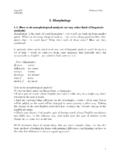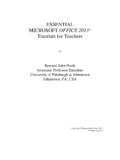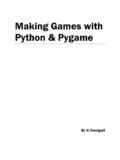Transcription of The Seven Types of Power Problems - SHI
1 The Seven Types of Power Problems White Paper 18. Revision 1. by Joseph Seymour Contents > Executive summary Click on a section to jump to it Introduction 2. Many of the mysteries of equipment failure, downtime, software and data corruption, are the result of a prob- Transients 4. lematic supply of Power . There is also a common problem with describing Power Problems in a standard Interruptions 8. way. This white paper will describe the most common Types of Power disturbances, what can cause them, Sag / undervoltage 9. what they can do to your critical equipment, and how to Swell / overvoltage 10. safeguard your equipment, using the IEEE standards for describing Power quality Problems .
2 Waveform distortion 11. Voltage fluctuations 15. Frequency variations 15. Conclusion 18. Resources 19. Appendix 20. white papers are now part of the Schneider Electric white paper library produced by Schneider Electric's data Center Science Center The Seven Types of Power Problems Introduction Our technological world has become deeply dependent upon the continuous availability of electrical Power . In most countries, commercial Power is made available via nationwide grids, interconnecting numerous generating stations to the loads. The grid must supply basic national needs of residential, lighting, heating, refrigeration, air conditioning, and transporta- tion as well as critical supply to governmental, industrial, financial, commercial, medical and communications communities.
3 Commercial Power literally enables today's modern world to function at its busy pace. Sophisticated technology has reached deeply into our homes and careers, and with the advent of e-commerce is continually changing the way we interact with the rest of the world. Intelligent technology demands Power that is free of interruption or disturbance. The consequences of large-scale Power incidents are well documented. A recent study in the USA has shown that industrial and digital business firms are losing $ billion per year due to Power interruptions. 1 Across all business sectors, an estimated $104 billion to $164 billion is lost due to interruptions with another $15 billion to $24 billion due to all other Power quality Problems .
4 In industrial automatic processing, whole production lines can go out of control, creating hazardous situations for onsite personnel and expensive material waste. Loss of processing in a large financial corporation can cost thousands of unrecoverable dollars per minute of downtime, as well as many hours of recovery time to follow. Program and data corruption caused by a Power interruption can create Problems for software recovery operations that may take weeks to resolve. Many Power Problems originate in the commercial Power grid, which, with its thousands of miles of transmission lines, is subject to weather conditions such as hurricanes, lightning storms, snow, ice, and flooding along with equipment failure, traffic accidents and major switching operations.
5 Also, Power Problems affecting today's technological equipment are often generated locally within a facility from any number of situations, such as local construc- tion, heavy startup loads, faulty distribution components, and even typical background electrical noise. Agreeing on common terms is a first step in dealing with Power disturbances Widespread use of electronics in everything from home electronics to the control of massive and costly industrial processes has raised the awareness of Power quality. Power quality, or more specifically, a Power quality disturbance, is generally defined as any change in Power (voltage, current, or frequency) that interferes with the normal operation of electrical equip- ment.
6 The study of Power quality, and ways to control it, is a concern for electric utilities, large industrial companies, businesses, and even home users. The study has intensified as equipment has become increasingly sensitive to even minute changes in the Power supply voltage, current, and frequency. Unfortunately, different terminology has been used to describe many of the existing Power disturbances, which creates confusion and makes it more difficult to effectively discuss, study, and make changes to today's Power quality Problems . The Institute of Electrical and Electronics Engineers (IEEE) has attempted to address this problem by developing a standard that includes definitions of Power distur- bances.
7 The standard (IEEE Standard 1159-1995, "IEEE Recommended Practice for Monitoring Electrical Power Quality") describes many Power quality Problems , of which this paper will discuss the most common. 1. Electric Power Research Institute, The Cost of Power Disturbances to Industrial & Digital Economy Companies, copyright 2001. Schneider Electric data Center Science Center White Paper 18 Rev 1 2. The Seven Types of Power Problems How do we look at Power ? Electricity at the wall outlet is an electromagnetic phenomenon. Commercial Power is provided as alternating current (AC), a silent, seemingly limitless source of energy that can be generated at Power stations, boosted by transformers, and delivered over hundreds of miles to any location in the region.
8 Seeing what this energy is doing in small slices of time can provide an understanding of how important simple, smooth ac Power is to reliable operation of the sophisticated systems that we are dependent upon. An oscilloscope allows us to see what this energy looks like. In a perfect world, commercial ac Power appears as a smooth, symmetrical sine wave, varying at either 50 or 60 cycles every second (Hertz Hz). depending on which part of the world you're in. Figure 1 shows what an average AC sine wave would appear like on an oscilloscope. Figure 1. Oscilloscope image of a sine wave The sinusoidal wave shape shown above represents a voltage changing from a positive value to a negative value, 60 times per second.
9 When this flowing wave shape changes size, shape, symmetry, frequency, or develops notches, impulses, ringing, or drops to zero (however briefly), there is a Power disturbance. Simple drawings representative of changes in the above ideal sine wave shape will be shown throughout this paper for the Seven categories of Power quality disturbances that will be discussed. As stated, there has been some ambiguity throughout the electrical industry and businesses community in the use of terminology to describe various Power disturbances. For example, the term surge is seen by one sector of the industry to mean a momentary increase in voltage as would be typically caused by a large load being switched off.
10 On the other hand, usage of the term surge can also be seen as a transient voltage lasting from microseconds to only a few milliseconds with very high peak values. These latter are usually associated with lightning strikes and switching events creating sparks or arcing between contacts. The IEEE Standard 1100-1999 has addressed the problem of ambiguity in terminology, and has recommended that many terms in common usage not be used in professional reports and references because of their inability to accurately describe the nature of the problem . IEEE. Standard 1159-1995 also addresses this problem with the goal of providing consistent terminology for Power quality reporting from the professional community.






